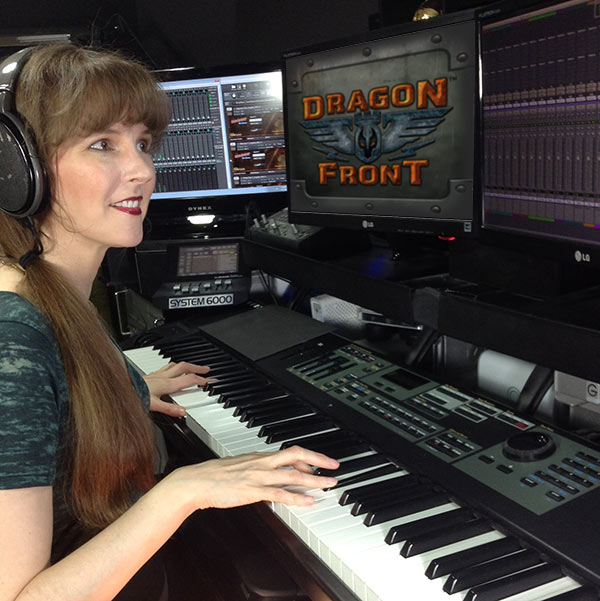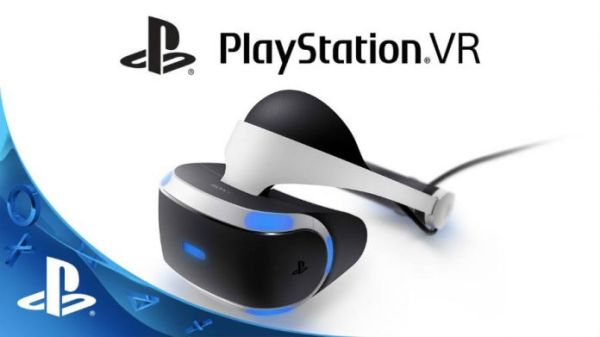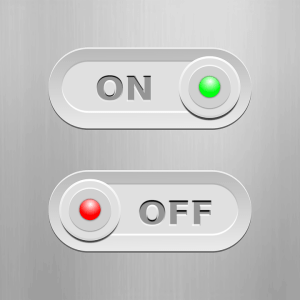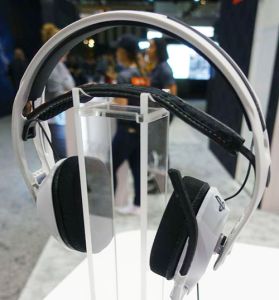Trending
Opinion: How will Project 2025 impact game developers?
The Heritage Foundation's manifesto for the possible next administration could do great harm to many, including large portions of the game development community.

Featured Blog | This community-written post highlights the best of what the game industry has to offer. Read more like it on the Game Developer Blogs or learn how to Submit Your Own Blog Post
How does headphone tech impact virtual reality? Video game music composer Winifred Phillips provides updates on VR headphone prototypes and consumer products. The issue of consumer confusion regarding headphone surround sound in VR is also discussed.


By Winifred Phillips | Contact | Follow
Last year while working on the music of the Dragon Front virtual reality game for Oculus Rift (as pictured above), I gave a lot of consideration to the listening environment in which VR gamers would be hearing my video game music. Since then I've served as the video game composer for several more virtual reality games (which will be released in the next few months). I've also written a number of articles on this subject in order to share what I've learned with other game composers. Last September I devoted two articles to a discussion of audio headphones designed specifically for the demands of virtual reality applications. You can read those here:
In addition, two years ago I wrote an article that focused on some of the top difficulties associated with choosing the right headphones for VR. You can read that article here:
Music Composers and Sound Designers in VR: The Headphones Problem
Now, I'd like to revisit the ideas discussed in those articles, so that we can see how the art of VR audio for headphones has progressed.
Let's start with that article I wrote about "the headphones problem," a critical issue regarding VR headphones that's still an important consideration today.
 In June of 2015, I wrote an article about the inadvisability of using surround headphones for VR games and experiences. At the time, most gamers were pointing to surround headphones as the best and most popular choice for awesome gaming audio. However, surround headphones were never meant to be used with the kind of audio spatialization currently employed in virtual reality development. VR games usually do not offer their audio in the famous surround-sound format, instead preferring the binaural format. Surround headphones are typically designed to process non-surround audio into an imitation of surround sound, and this type of signal processing can play havoc with the expert crafting of a spatialized VR soundscape.
In June of 2015, I wrote an article about the inadvisability of using surround headphones for VR games and experiences. At the time, most gamers were pointing to surround headphones as the best and most popular choice for awesome gaming audio. However, surround headphones were never meant to be used with the kind of audio spatialization currently employed in virtual reality development. VR games usually do not offer their audio in the famous surround-sound format, instead preferring the binaural format. Surround headphones are typically designed to process non-surround audio into an imitation of surround sound, and this type of signal processing can play havoc with the expert crafting of a spatialized VR soundscape.
 Since my June 2015 article was published, there have been signs that this issue is being considered and addressed by audio professionals working in VR. The official FAQ page for the PlayStation VR now advises users to either turn off surround sound mode or use standard stereo headphones when playing their VR games. "Any surround sound generated by the headphones themselves will interfere with the 3D audio from the PS VR headset," warns the official PS VR FAQ page.
Since my June 2015 article was published, there have been signs that this issue is being considered and addressed by audio professionals working in VR. The official FAQ page for the PlayStation VR now advises users to either turn off surround sound mode or use standard stereo headphones when playing their VR games. "Any surround sound generated by the headphones themselves will interfere with the 3D audio from the PS VR headset," warns the official PS VR FAQ page.
While this warning is a step in the right direction, it isn't echoed by similar warnings elsewhere. A look at the Oculus Rift and HTC Vive web sites doesn't reveal any advice regarding the use (or avoidance) of surround sound headphones. Also, some video gaming sites are using terms like "full surround sound" to describe the best audio experience in VR, or are describing VR audio as "creating surround sound within a pair of headphones." These sorts of statements have the potential to lead consumers to draw the incorrect conclusion that surround sound headphones are the best choice for VR.
Last September I wrote two articles about headphones designed specifically for VR. At the time, I focused on four headphone models offering differing features and technologies to enhance the enjoyment of audio in the VR environment. Most of these headphones were either in development or crowdfunding stages and not yet available to the public. Since I planned to post updates about those headphones in this article, I began by doing some research to see what had happened over the course of the intervening year. During this research, I noticed that one of the VR headphone models from my previous article was actively advertising its surround sound capabilities. With that in mind, I thought that a bit of clarification would now be in order:
 After reading an early review article from PCWorld.com of the OSSIC X headphones, I was struck by the emphasis on the surround sound capabilities of the headphones, and the (incorrrect) assumption on the part of the PCWorld reviewer that surround sound headphones are preferable for VR. "(Surround-sound headsets are) definitely better than stereo headsets, especially for VR, but far from ideal," writes PCWorld.
After reading an early review article from PCWorld.com of the OSSIC X headphones, I was struck by the emphasis on the surround sound capabilities of the headphones, and the (incorrrect) assumption on the part of the PCWorld reviewer that surround sound headphones are preferable for VR. "(Surround-sound headsets are) definitely better than stereo headsets, especially for VR, but far from ideal," writes PCWorld.
While the OSSIC X headphones (pictured left) include surround-sound compatibility, this function is not what distinguishes the OSSIC X in VR. Instead, the OSSIC X headphones feature a multi-driver array (illustrated right) that allows the audio content to be spatialized with a greater degree of accuracy than what is afforded by typical stereo headphones. This multi-driver technology operates in tandem with the audio localization data in a virtual reality game, enabling the OSSIC X to effectively localize sounds to their exact spatial positions in VR. However, in order for the OSSIC X to fully utilize its drivers for this purpose, it needs to be able to communicate with the game's audio data by virtue of a plugin developed by OSSIC. "Developers will need to work with the OSSIC plugin to be able to make full use of the OSSIC technology," says Sally Kellaway, OSSIC's Creative Director.
This multi-driver technology operates in tandem with the audio localization data in a virtual reality game, enabling the OSSIC X to effectively localize sounds to their exact spatial positions in VR. However, in order for the OSSIC X to fully utilize its drivers for this purpose, it needs to be able to communicate with the game's audio data by virtue of a plugin developed by OSSIC. "Developers will need to work with the OSSIC plugin to be able to make full use of the OSSIC technology," says Sally Kellaway, OSSIC's Creative Director.
So, what if the VR game we're currently playing wasn't designed to be compatible with the OSSIC plugin? Will the OSSIC X still provide any extra spatial enhancement? The official website lets us know that "any existing stereo content can be spatialized as a virtual soundstage." A gamer might think, 'binaural is essentially a stereo format, so maybe the extra spatialization will make this VR audio cooler!' However, that kind of spatialization isn't at all desirable for VR games, according to Kellaway. "In the use case where the OSSIC X is being used with a VR game that is developed with a generic plugin, the (OSSIC X) can be put into “bypass” mode that basically just reverts them back to standard headphones. At this point, you don’t get the majority of the features, but they’re still extremely high quality headphones that have been developed to sound great and provide a passively isolated experience."
 So, OSSIC advises us to check that our VR game is running the compatible plugin, and if it isn't, to put them into "bypass mode" which will essentially turn any extra spatial processing off. That's an important detail to know about, and OSSIC is committed to keeping its user-base informed. "The OSSIC processing and Headtracking can be switched on and off by the listener," Kellaway tells us, "and it’s one of our key goals to educate our customers on how to use their headphones with all types of media."
So, OSSIC advises us to check that our VR game is running the compatible plugin, and if it isn't, to put them into "bypass mode" which will essentially turn any extra spatial processing off. That's an important detail to know about, and OSSIC is committed to keeping its user-base informed. "The OSSIC processing and Headtracking can be switched on and off by the listener," Kellaway tells us, "and it’s one of our key goals to educate our customers on how to use their headphones with all types of media."
When used with a compatible VR game, the OSSIC X promises a mind-blowing sonic experience. Unfortunately, the production schedule for the headphones has been slower than originally anticipated. While the Developer Kickstarter units were scheduled to be shipped in August 2017, developers are reporting that their OSSIC X developer units have only now begun to arrive. Meanwhile, OSSIC has ceased taking pre-orders, meaning that consumers can only add their information to a waitlist and hope for the best.
Now, let's take a quick look at the three other VR headphone models I wrote about last year, to see how things have developed:
 The Plantronics RIG 4VR (pictured right) has now hit retail. These headphones are distinguished primarily by a color scheme that coordinates with the PlayStation VR and smaller earcups that don't bump up against the PSVR headgear. TrustedReviews gave the Plantronics RIG 4VR four-out-of-five stars. "Sure, you can get headphones that offer greater detail and dynamism," writes Ced Yuen of TrustedReviews, "but if you want the two-way audio of a headset, and one that looks like it was made for your fancy new VR kit, this does the job nicely."
The Plantronics RIG 4VR (pictured right) has now hit retail. These headphones are distinguished primarily by a color scheme that coordinates with the PlayStation VR and smaller earcups that don't bump up against the PSVR headgear. TrustedReviews gave the Plantronics RIG 4VR four-out-of-five stars. "Sure, you can get headphones that offer greater detail and dynamism," writes Ced Yuen of TrustedReviews, "but if you want the two-way audio of a headset, and one that looks like it was made for your fancy new VR kit, this does the job nicely."
Unfortunately, there's bad news for anyone looking forward to the release of these headphones. The CEEK VR company promised that the CEEKARS VR headphones (pictured below) would offer haptic feedback in the headband, as well as on-board physics-based audio rendering that would enhance the spatialization of VR sound without the need for any special software development kits or plugins. However, in February of last year, the CEEK VR founder Mary Spio told the project's backers that she anticipated there'd be "a few more months to go" before the headphones would be available, and that backers should request a refund. The company has promised to run a new crowdfunding campaign in the indeterminate future when they are closer to launch. In the meantime, the product has disappeared from the CEEK VR website. It seems that the company has turned its focus to their CEEK Virtual Reality headset system. Ironically, the headset is pictured on their website without any audio delivery of any kind (earbuds or headphones).
However, in February of last year, the CEEK VR founder Mary Spio told the project's backers that she anticipated there'd be "a few more months to go" before the headphones would be available, and that backers should request a refund. The company has promised to run a new crowdfunding campaign in the indeterminate future when they are closer to launch. In the meantime, the product has disappeared from the CEEK VR website. It seems that the company has turned its focus to their CEEK Virtual Reality headset system. Ironically, the headset is pictured on their website without any audio delivery of any kind (earbuds or headphones).
 These headphones (pictured right) were promised to offer us a very unique experience. When wearing these headphones, our heads would receive a set of electrical signals that would stimulate our galvanic vestibular systems, creating specific sensations of movement by manipulating our sense of balance. Unfortunately, since I wrote about these headphones last year, the manufacturer Samsung has released no subsequent information, and there's been no news about any projected release date. Considering that these headphones send electrical signals into people's heads, we may be safe in assuming that they'll require extensive safety testing prior to launch. On the other hand, it may be that Samsung has very quietly ceased development on the Entrim 4D headphones project. I'll continue to keep an eye out for any news about this intriguing headphone technology.
These headphones (pictured right) were promised to offer us a very unique experience. When wearing these headphones, our heads would receive a set of electrical signals that would stimulate our galvanic vestibular systems, creating specific sensations of movement by manipulating our sense of balance. Unfortunately, since I wrote about these headphones last year, the manufacturer Samsung has released no subsequent information, and there's been no news about any projected release date. Considering that these headphones send electrical signals into people's heads, we may be safe in assuming that they'll require extensive safety testing prior to launch. On the other hand, it may be that Samsung has very quietly ceased development on the Entrim 4D headphones project. I'll continue to keep an eye out for any news about this intriguing headphone technology.
So, that concludes this article that gathers together some of the developments in headphones designed for VR. Please let me know what you think in the comments below!
 Winifred Phillips is an award-winning video game music composer whose recent projects include the triple-A first person shooter Homefront: The Revolution and the Dragon Front VR game for Oculus Rift. Her credits include games in five of the most famous and popular franchises in gaming: Assassin’s Creed, LittleBigPlanet, Total War, God of War, and The Sims. She is the author of the award-winning bestseller A COMPOSER'S GUIDE TO GAME MUSIC, published by the MIT Press. As a VR game music expert, she writes frequently on the future of music in virtual reality games.
Winifred Phillips is an award-winning video game music composer whose recent projects include the triple-A first person shooter Homefront: The Revolution and the Dragon Front VR game for Oculus Rift. Her credits include games in five of the most famous and popular franchises in gaming: Assassin’s Creed, LittleBigPlanet, Total War, God of War, and The Sims. She is the author of the award-winning bestseller A COMPOSER'S GUIDE TO GAME MUSIC, published by the MIT Press. As a VR game music expert, she writes frequently on the future of music in virtual reality games.
Follow her on Twitter @winphillips.
Read more about:
Featured BlogsYou May Also Like